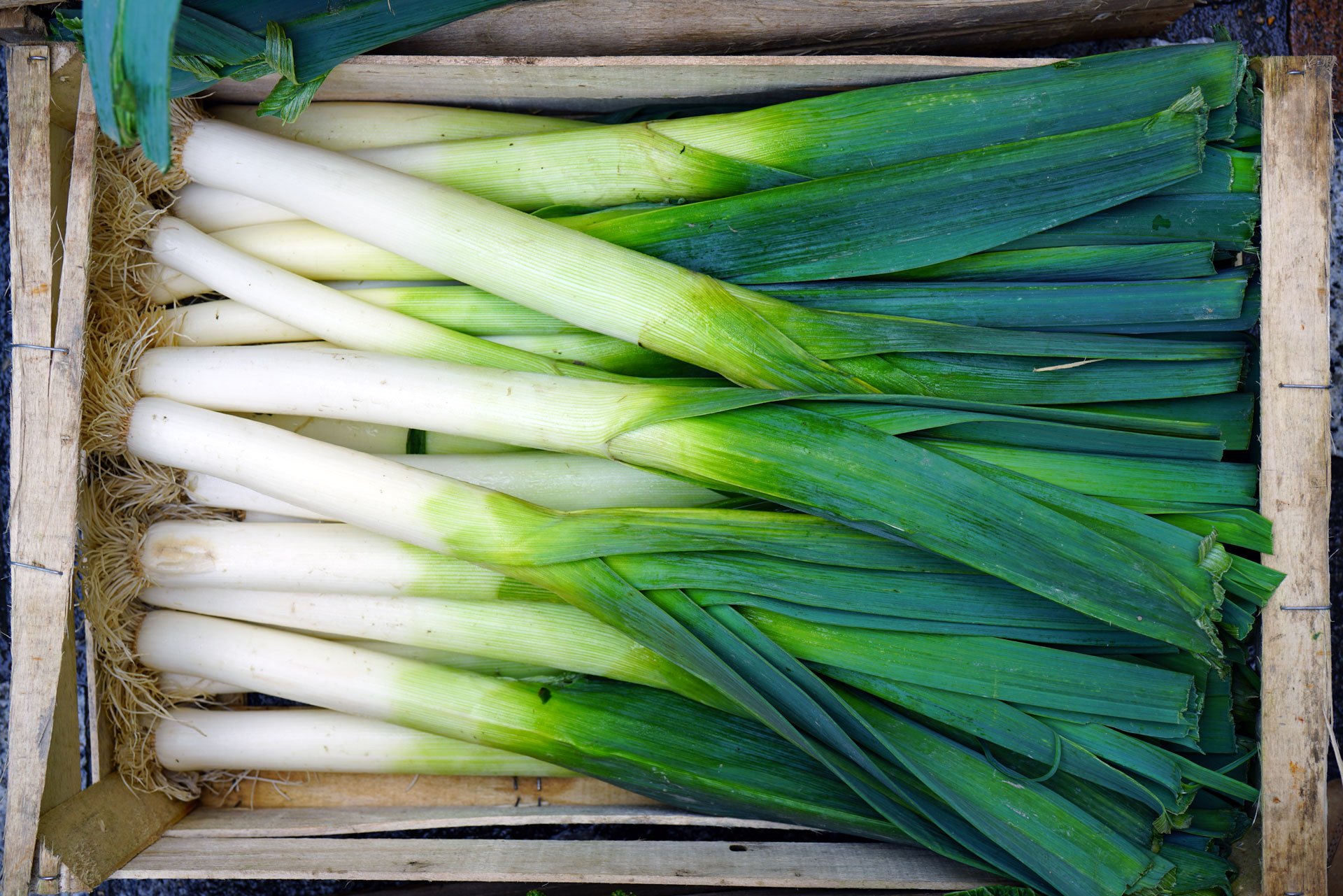Real Food Encyclopedia | Leek
Leeks (Allium porrum, part of the pungent Allium family (of which garlic and onions are members), are native to North Africa and Eurasia. They were probably first cultivated by the Egyptians, who liked them so much they painted their tombs with images of them. The ancient Greeks and Romans were also big leek lovers: Romans viewed the leek as a more refined version of its onion and garlic cousins, which is how many contemporary cooks view them as well.
Fun Facts about Leeks:
- They are toxic to dogs and cats, so keep them (and their Allium relatives) away from your furry friends.
- The beautiful and tasty Allium family also includes onions, garlic, shallots, ramps, scallions, chives and a number of ornamentals grown for their unique globe-shaped flower heads.
What to look for when buying leeks
Common leeks kind of look like a giant scallion. They have a straight, white stem that gradually becomes lighter green, making way to the dark, almost blue-green of the top leaves. Kurrat, the so-called “Middle Eastern” leek, has fewer tough green, outer leaves (which are frequently eaten, unlike the leaves of the common leek).
Seek out leeks on the smaller side, one to two inches in stem diameter, three inches tops. Larger ones are okay, but they tend to get woody and a bit tough. The greens should be a very dark green with no yellowing or wilted spots. The white stem should be very white and firm with no black, mushy or discolored areas.
Sustainability of leeks
The good news is that leeks do not appear on the Environmental Working Group’s Shopper’s Guide to Pesticides in Produce. The bad news is that a lot of pesticides are approved for use on leeks. (Here’s a list of pesticides used on leeks grown in California.) If you are concerned about pesticide use, buy locally and ask your farmer about pesticide usage, or look for organic leeks at the store.
Seasonality
Leeks are very cold tolerant. Some varieties can withstand multiple frosts over an entire winter, making them an excellent cold-weather vegetable that can be harvested into the following spring. However, there are also varieties that are bred for harvest in the summer, ensuring year-round availability.
Eating leeks
Storing
Leeks will keep in your veggie drawer, wrapped in a paper towel, for at least a week. Don’t wash them before you refrigerate them, as this accelerates their decline.
Cooking
Like their Allium brethren, they are remarkably versatile in the kitchen. They have a mild onion-y, sweet flavor that lend themselves to all sorts of dishes.
Most recipes call for only the “white and light green parts” of the vegetable, but the dark green leaves can be saved to use in stock making (veggie, beef, chicken, etc.). The stems can be braised, grilled, roasted, fried (or “frizzled“), steamed, sautéed and used raw in salads as they are a lot less shocking to the palate than raw onions. Toss them into your favorite soups or stews in place of onions for a more delicate flavor. They pair beautifully with dairy products (think butter, cream and cheese), and with eggs, chicken, potatoes, fish and the leeks’ Allium relatives (chives, garlic).
One of the most famous leek dishes, the chilled potato and leek soup vichyssoise, was invented in New York by a French chef. Another famous leek-based dish, the Scottish cock-a-leekie soup, is traditionally made with chicken, leeks and prunes. Leeks vinaigrette is another renowned dish highlighting the beauty and delicacy of the vegetable. And here is an interesting leek-and-matzo casserole for Passover that has Egyptian origins, which is fitting, given the leek’s history.
The thing about preparing them is that they are very dirty, with gritty bits of sand frequently hidden in the layers that make up the stems. They have to be cleaned very thoroughly. David Lebovitz has a good description of how to clean leeks, or here is a great video that shows two different techniques for cleaning the veggie.
Preserving
Here is a fun recipe for quick pickled leeks that will keep for up to two weeks in the fridge. You can also pickle leek scapes (the flower stalk of the leek). And here is a yummy pear-and-leek lacto-fermented chutney. Leeks can also be frozen successfully.
Nutrition
Leeks are very high in Vitamins A and K and are good sources of Vitamin B-6, folate, iron, calcium and manganese. They are also high in fiber and low in calories. Leeks are also a mild diuretic (there is even a “leek soup diet” that supposedly helps with weight loss) and are high in antioxidant polyphenols. In general, allium family members have been linked to improved cardiovascular health and are used as a remedy for inflammation.
Top photo by zigzagmtart/Adobe Stock.


